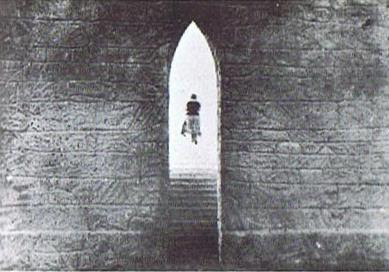Trama
La vita in un tranquillo paese di campagna è stravolta dall’arrivo di un sinistro straniero, che dopo aver stupito i paesani alla locanda locale, si stabilisce in un terreno vicino al cimitero, circondato da alte mura.
Qui vengono visti cortei di anime entrare: fra essi una ragazza riconosce il suo innamorato, che scompare. Disperata cerca di accedere alla casa misteriosa e dopo esserci riuscita scopre che si tratta della casa della Morte, piena di candele che rappresentano le vite umane che si stanno consumando.
Le viene allora offerta la possibilità di ricongiungersi al suo fidanzato, salvando una almeno delle tre vite che stanno per spegnersi. Alla fine la ragazza dona la sua vita per un’altra persona, ritrovando il giovane amato nel regno dei morti.
Struttura
«Ballata popolare tedesca in sei canti», recita la didascalia iniziale. Il film dichiara la sua struttura e l’atmosfera musicale che lo caratterizzano. Come una ballata, è composto da un antefatto; tre storie in costume; un ultimo atto; il finale.
cinema obscura: Fritz Lang’s “Destiny”/”Der Müde Tud” (1921)
Scenes from Lang’s “Destiny”/”Der Müde Tud”: The Wall (above) and Lil Dagover and Bernhard Goetzke as the ingenue and death in disguise (below)
Master filmmaker Fritz Lang thrusts the viewer into an intense emotional whirlpool in his 1921 silent film, “Destiny” (“Der Müde Tud”), one of the lesser known titles in his canon of work but an achievement that I’ve always found compulsively watchable and utterly fascinating.
Its inaccessibility, now that rep houses and a lot of campus film programs are sadly out of business, becomes a temporary thing of the past now that New York’s Rubin Museum of Art (150 West 17th street) has scheduled it for a 9:30 p.m. showing as part of its Cabaret Cinema program on Friday, 14 May.
The dream-like tale of two lovers whose future together is dimmed when Death (Bernhard Goetzke) materializes and snatches the young man (Walter Janssen), “Destiny” is the kind of film that, on paper, can sound positively purple. The young woman (Lil Dagover) contemplates suicide when Death challenges her with a deal that she can hardly refuse: There’s a boy and there are three candles, each representing a human life. As each candle is extinguished, someone dies. But if one candle stays lighted, the boy will be spared and survive.
This main storyline gives way to three subplots – set in ancient Persia, Renaissance Venice and China – that are both wildly methaphorical and metaphysical as the woman frantically searches for someone to give up their life once the boy’s is spared. The elderly, who are at death’s doorstep, run for her. There is some alert, unexpected humor in this death-drenched fable, and the heroine confronts carefully designed stumbling blocks, until she and her lover are reunited in a way that can only be described as supremely Lang-ian. Relax. No spoiler here.

I’ve always been struck by the methodical pace and overriding sense of calm that Lang brought to his very dark, moody fairy tale. He kept things in check here, both his direction of the material and the performances of his cast. The result is an impressively muted film.
Fritz Lang brilliantly deconstructs the notion of romantic filmmaking with “Der Müde Tud,” which translates incidentially – and tellingly – as “The Tired Death.”
Catch it if you can at the Rubin where Thomas Rutishauser will accompany it on the cello.
http://thepassionatemoviegoer.blogspot.it/2010/05/cinema-obscura-fritz-langs-destinyder.html
The Woman in the Window, LA DONNA DEL RITRATTO F. Lang ; Close Examination: ‘Woman at a Window”| The National Gallery, London
Clash By Night – La confessione della signora Doyle Fritz .
Top 5 – Fritz Lang | controappuntoblog.org
You Only Live Once Friz Lang : sono innocente | controappun




